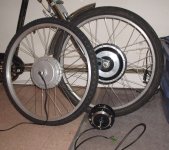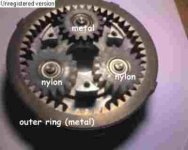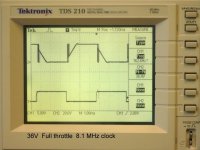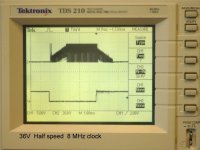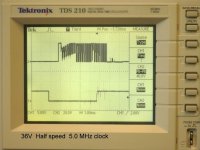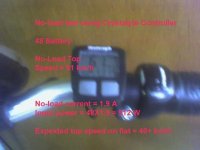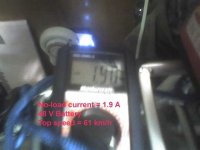Here's a Thought for a DIY Project and everything is in stock right now.
PHASE I …
a) Buy a Bafang front PMGR motor (motor only) as cheap as you can from Keywin.
Tell him to add his stock (16-mhz) 72V controller (w/ 80nf10 fets) and a throttle too.
b) Order some 216mm spokes for a 26" wheel (like these ... http://www.amazon.com/Spokes-Wheel-Master-144-216Mm/dp/B000BMRS4S).
(Verification of the 216mm length is appreciated for one-cross spoke lacing. The motor spoke hole pattern diameter is 130mm.)
I determined the lace pattern and spoke length using AutoCAD. 216mm seems about right.
The motor reference drawing is here ... http://98.131.176.65/endless-sphere/QSWXBfrontwheel.pdf
c) Tweak the LVC (fechter style) and bypass the resistors to the voltage regulator cascade to suit your bat pack V (no mod needed for 72V).
d) Replace the 16-mhz resonator with a new 24-mhz resonator (looks easy now).
24-mhz replacement resonator is here ... http://cgi.ebay.com/ws/eBayISAPI.dll?ViewItem&item=270185419501&ru=http%3A%2F%2Fsearch.ebay.com%3A80%2Fsearch%2Fsearch.dll%3Ffrom%3DR40%26_trksid%3Dm37%26satitle%3D270185419501%26category0%3D%26fvi%3D1
20-mhz replacement resonator should also work for the Bafang ... http://search.digikey.com/scripts/DkSearch/dksus.dll?Detail?name=X909-ND
(or maybe just ask Keywin to upgrade the resonator to 24-mhz for free)
BTW ... PLEASE LEAVE SHUNTS ALONE! 30 amps is plenty for the Bafang ... IMHO
e) Lace the motor into your own 36-spoke 26" rim.
You have now invented your own little custom Bafang Front Hub beta test!
All that is left now is to monitor the motor temp, harness temp and tearing-it-up at 35 mph (72V and 30 amps).
And I am hoping that the motor will tear-up the road and not vice-versa.
Please Ride Responsibly!
PHASE II …
a) Buy a Bafang rear PMGR motor (motor only) as cheap as you can from Keywin.
Tell him to add his stock (16-mhz) 72V controller (w/ 80nf10 fets).
A second throttle is not needed.
b) Order the correct spokes for a dished 26" rear wheel (like maybe 214mm and 216mm).
(Verification of the specific spoke lengths for a dished rear wheel is appreciated for one-cross spoke lacing. Same motor spoke hole pattern diameter of 130mm.)
The rear motor reference drawing is here ... http://98.131.176.65/endless-sphere/7speedrearwheel.pdf
Add your own thread-on freewheel cassette (and maybe a rear disc brake too).
c) Tweak the LVC (fechter style) and bypass the resistors to the voltage regulator cascade to suit your bat pack V (no mod needed for 72V).
d) Replace the 16-mhz resonator with a new 24-mhz resonator (get's even easier the second time) or tell Keywin to do it for free.
Connect the two controllers to the same throttle.
e) Lace the rear motor into your own 36-spoke 26" rim.
The rear wheel spokes are dished (each side different length).
The center line of the wheel should align between the rear frame (142mm wide drop-outs) of the bike.
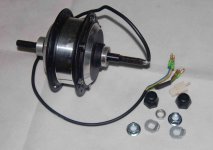
You have now invented your own little custom Bafang Front+Rear Hub beta test 2X2 Monster Bike!
All that is left now is to monitor the front and rear motor and harness temperatures.
And, of course, tearing-it-up at 'Ludicrous Speed' (72V and 60 amps total).
And I am confident that the 2 motors will tear-up the road and climb hills like a MF.
A 2X2 Monster Bike with two Bafang PMGR motors and two 72V 30 amps controllers and some serious Lithium.
Please Ride Responsibly!
PS If you want lifepo4 bats then ask Keywin for that too! All in one nice compact box.
(Just no rims. You provide the rims. You lace the motors. Smaller delivery box. YOU Save $$$.)
easy peasy! ha ha


